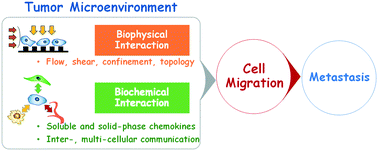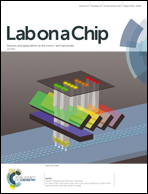Cell migration in microengineered tumor environments
Abstract
Recent advances in microengineered cell migration platforms are discussed critically with a focus on how cell migration is influenced by engineered tumor microenvironments, the medical relevance being to understand how tumor microenvironments may promote or suppress the progression of cancer. We first introduce key findings in cancer cell migration under the influence of the physical environment, which is systematically controlled by microengineering technology, followed by multi-cues of physico-chemical factors, which represent the complexity of the tumor environment. Recognizing that cancer cells constantly communicate not only with each other but also with tumor-associated cells such as vascular, fibroblast, and immune cells, and also with non-cellular components, it follows that cell motility in tumor microenvironments, especially metastasis via the invasion of cancer cells into the extracellular matrix and other tissues, is closely related to the malignancy of cancer-related mortality. Medical relevance of forefront research realized in microfabricated devices, such as single cell sorting based on the analysis of cell migration behavior, may assist personalized theragnostics based on the cell migration phenotype. Furthermore, we urge development of theory and numerical understanding of single or collective cell migration in microengineered platforms to gain new insights in cancer metastasis and in therapeutic strategies.

- This article is part of the themed collection: Lab on a Chip Recent Review Articles


 Please wait while we load your content...
Please wait while we load your content...